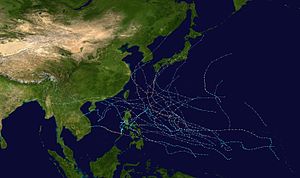Our website is made possible by displaying online advertisements to our visitors.
Please consider supporting us by disabling your ad blocker.
1979 Pacific typhoon season
| 1979 Pacific typhoon season | |
|---|---|
 Season summary map | |
| Seasonal boundaries | |
| First system formed | December 31, 1978 |
| Last system dissipated | December 23, 1979 |
| Strongest storm | |
| Name | Tip (Most intense tropical cyclone ever recorded) |
| • Maximum winds | 260 km/h (160 mph) (10-minute sustained) |
| • Lowest pressure | 870 hPa (mbar) |
| Seasonal statistics | |
| Total depressions | 54 |
| Total storms | 24 |
| Typhoons | 12 |
| Super typhoons | 4 (unofficial) |
| Total fatalities | 541 total |
| Total damage | $2.24 billion (1979 USD) |
| Related articles | |
The 1979 Pacific typhoon season featured the largest and most intense tropical cyclone recorded globally, Typhoon Tip. The season also used both male and female names as tropical cyclone names for the first time. Additionally, the season was slightly below-average in terms of tropical cyclone activity, with only 24 storms, 12 typhoons, and 4 super typhoons developing. The season had no official bounds; it ran year-round in 1979, but most tropical cyclones tend to form in the northwestern Pacific Ocean between June and December. These dates conventionally delimit the period of each year when most tropical cyclones form in the northwestern Pacific Ocean.
The scope of this article is limited to the Pacific Ocean, north of the equator and west of the International Date Line. Storms that form east of the date line and north of the equator are called hurricanes; see 1979 Pacific hurricane season. Tropical storms formed in the entire west Pacific basin were assigned a name by the Joint Typhoon Warning Center. Tropical depressions in this basin have the "W" suffix added to their number. Tropical depressions that enter or form in the Philippine area of responsibility are assigned a name by the Philippine Atmospheric, Geophysical and Astronomical Services Administration or PAGASA. This can often result in the same storm having two names.
Previous Page Next Page


